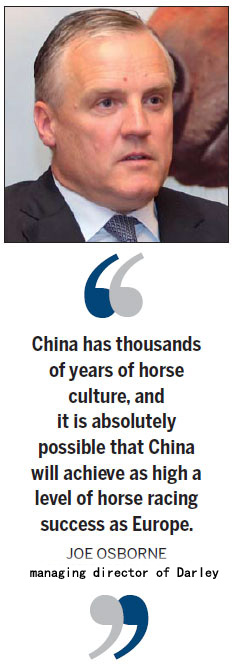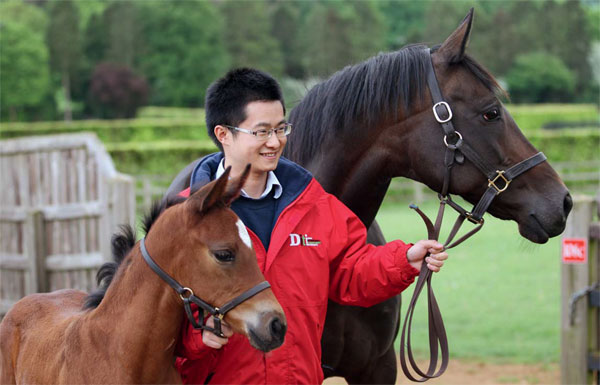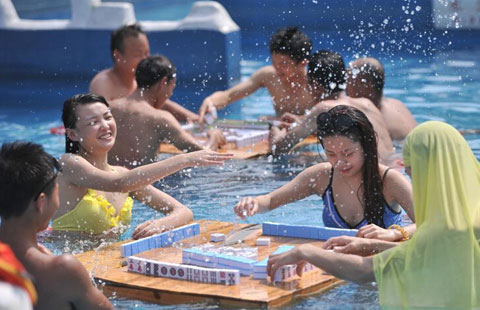The highest hurdle of them all
Updated: 2014-06-27 07:33
By Wang Chao (China Daily Europe)
|
|||||||||||
|
A student with Darley Dubai International Thoroughbred Internships program walks on a horse course in England. The lack of a professional base is a big hurdle for the Chinese horse racing industry. Photos provided to China Daily |
Horse racing in china remains hobbled by a government ban on betting
Chinese President Xi Jinping was given a valuable gift by Turkmen President Gurbanguly Berdimuhamedov when they met in Beijing in May.
The gift was a majestic Akhal-Teke horse, a paragon of speed and endurance and the oldest thoroughbred breed in the world. The horses, a Turkmenistan national treasure, are not for sale.
The horse diplomacy was cited by many who are betting on horse racing's future in China as a sign that the industry is ready to take the spotlight.
The China Horse Industry Association says there are more than 300 registered jockey clubs in China, and about 500,000 people who work in horse-related industries, though fewer than 5,000 are specifically involved in racing.
The Chinese horse racing industry has the potential to become much larger, says Joe Osborne, managing director of Darley. Darley is an organization sponsored by Sheikh Mohammed bin Rashid Al Maktoum, prime minister of the United Arab Emirates, to promote thoroughbred breeding worldwide.
"China has thousands of years of horse culture, and it is absolutely possible that China will achieve as high a level of horse racing success as Europe," Osborne says. "Given some time, China can even be the top horse racing country in the world."
But there is a catch. Cui Chuping, manager of international business expansion for China Horse International Holdings, a horse-related investment and operations company in Beijing, says: "In mature markets such as the UK, US and Australia, thoroughbred horse racing raises funds from betting, so there is more engagement from the public, and part of this money is then invested in horse breeding and jockey training."
The company is one of the organizers of the International Akhal-Teke Horses Association Special Conference and China Horse Culture Festival in Beijing, where the recent horse diplomacy happened.
While betting on horse racing was banned in 1949, the lack of specific legislation left some gray areas. In the early 1990s, Xi'an, capital of Shaanxi province, began awarding prizes for races. Soon racing spread across the country and a large number of racecourses were built within a few years. Guangzhou introduced some betting and about 300 million yuan collected after seven consecutive years of horse racing was used for charity and to develop the equestrian industry.

But in the early 2000s, the central government banned all betting on horses, and racecourses were gradually abandoned or used for other purposes.
There has been speculation that the government will change its mind, though some concede that this is a long shot. However, optimists are not deterred.
"Horse betting money is an effective way to raise money for philanthropic purposes, and part of it will be used to support the local breeding industry," Cui says.
Chinese jockey clubs and racecourses mainly live on sponsorships and advertising, and their income is much smaller than in Western countries.
"Horse racing is very expensive as it requires a course, horses and related inspections," says Louis Romanet, chairman of the International Federation of Horseracing Authorities, founded in 1961 to coordinate rules regarding racing, breeding and wagering in member countries. "Without a sustainable way of fundraising, it is hard to make breakthroughs."
Thoroughbreds are expensive, even before their care is taken into account. In the 1980s, the breeding fee alone for a Canadian horse named Northern Dancer was $1 million. The highest price for a thoroughbred at auction was set in 2006 at $16 million for a two-year-old named The Green Monkey, a descendant of Northern Dancer. Average prices for yearlings are in the range of $50,000, but prices vary greatly.
Despite high costs, horse racing has thrived and made important economic contributions in other countries and regions with riding traditions such as Australia. The world's richest horse race, the Dubai World Cup, had $27.25 million in prize money this year and, organizers said, attracted a worldwide audience of about millions.
Many proponents say horse racing could bring many economic benefits to China, especially if betting were allowed.
"Take France as an example, there are more than 70,000 people working in horse racing businesses, and among them 45,000 work at breeding facilities," Romanet says.
Horse racing is worth more than 3.7 billion pounds ($6.3 billion, 4.6 billion euros; ) annually to the economy of Britain, a cradle of modern racing. The first recorded race in England was in Henry II's reign in 1174. The Jockey Club, established in 1750, codified the rules.
In Ireland, horse breeding and racing is the second-largest industry in the country, worth 1 billion euros ($1.36 billion) last year, just behind cattle breeding. It has even prompted scientific research and new products, including two brands well-known in the business, Equinome, a genetic test to identify the racing potential of individual thoroughbred horses, and Equilume, a light-limiting mask that regulates mares' breeding cycles.
However, in China, horse racing is more about entertainment than sport, Cui says. And the revenue comes mainly from sponsorship and tickets.
Still, all the activities that go into the business, such as breeding, auctions and races, offer significant market potential.
In an attempt to grow interest in racing, Chinese companies are introducing variations of the sport. China Horse International is talking with the French Trotting Association about introducing a harness racing festival to China. The horses race at a controlled gait like a trot and usually pull two-wheeled carts called sulkies.
Some companies bundle horse racing with real estate to add value to their properties. In suburban Beijing, a racecourse is part of an entertainment park including a theme park and shopping malls.
Apart from money, the lack of professionals to help the industry develop is a big problem, Cui says.
Most professional riders in China are from Inner Mongolia or the Xinjiang Uygur autonomous region, areas with wide prairies and a deeply ingrained tradition of horseback riding. There are even fewer experts in raising and breeding racing horses in China, which is not a member of any international horse racing authorities.
Efforts are being made to expand the professional base. Darley has selected 20 students and 10 horse racing professionals from China for training at its facilities around the world every year since 2012.
Another issue is the lack of support services. Cui's company made special arrangements to borrow a dozen Akhal-Teke horses from Turkmenistan to perform at the International Akhal-Teke Association Special Conference, and each horse was worth millions of dollars but organizers could not find insurance companies who could insure them, Cui said.
Osborne says lack of infrastructure and regulation also stand in the way of Chinese horse racing.
"If Chinese people really want to bring this to the international level, there needs to be rules, regulations and proper facilities."
wangchao@chinadaily.com.cn
(China Daily European Weekly 06/27/2014 page21)
Today's Top News
TransAsia crash while landing in Taiwan
UK fraud office liaising with China on GSK bribery case
Death toll in Gaza mounts to 701
Meat supplier in global crisis
Dogs 'capable' of feeling jealousy
Five detained over stale meat scandal
5 more universities set up human rights centers
Rebels likely downed jet 'by mistake'
Hot Topics
Lunar probe , China growth forecasts, Emission rules get tougher, China seen through 'colored lens', International board,
Editor's Picks

|

|

|

|

|

|






